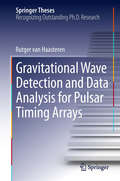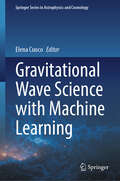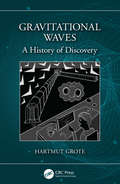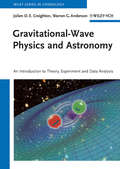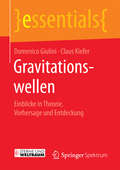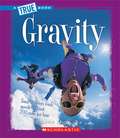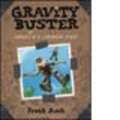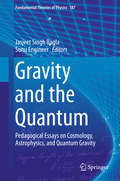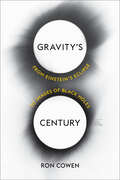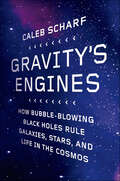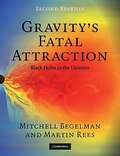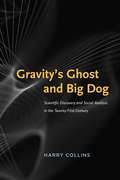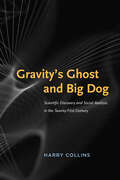- Table View
- List View
Gravitational Wave Detection and Data Analysis for Pulsar Timing Arrays
by Rutger HaasterenPulsar timing is a promising method for detecting gravitational waves in the nano-Hertz band. In his prize winning Ph. D. thesis Rutger van Haasteren deals with how one takes thousands of seemingly random timing residuals which are measured by pulsar observers, and extracts information about the presence and character of the gravitational waves in the nano-Hertz band that are washing over our Galaxy. The author presents a sophisticated mathematical algorithm that deals with this issue. His algorithm is probably the most well-developed of those that are currently in use in the Pulsar Timing Array community. In chapter 3, the gravitational-wave memory effect is described. This is one of the first descriptions of this interesting effect in relation with pulsar timing, which may become observable in future Pulsar Timing Array projects. The last part of the work is dedicated to an effort to combine the European pulsar timing data sets in order to search for gravitational waves. This study has placed the most stringent limit to date on the intensity of gravitational waves that are produced by pairs of supermassive black holes dancing around each other in distant galaxies, as well as those that may be produced by vibrating cosmic strings. Rutger van Haasteren has won the 2011 GWIC Thesis Prize of the Gravitational Wave International Community for his innovative work in various directions of the search for gravitational waves by pulsar timing. The work is presented in this Ph. D. thesis.
Gravitational Wave Science with Machine Learning (Springer Series in Astrophysics and Cosmology)
by Elena CuocoThis book highlights the state of the art of machine learning applied to the science of gravitational waves. The main topics of the book range from the search for astrophysical gravitational wave signals to noise suppression techniques and control systems using machine learning-based algorithms. During the four years of work in the COST Action CA17137-A network for Gravitational Waves, Geophysics and Machine Learning (G2net), the collaboration produced several original publications as well as tutorials and lectures in the training schools we organized. The book encapsulates the immense amount of finding and achievements. It is a timely reference for young researchers approaching the analysis of data from gravitational wave experiments, with alternative approaches based on the use of artificial intelligence techniques.
Gravitational Waves
by Ugo Moschella Vittorio Gorini Ignazio Ciufolini Pietro FréGravitational waves (GWs) are a hot topic and promise to play a central role in astrophysics, cosmology, and theoretical physics. Technological developments have led us to the brink of their direct observation, which could become a reality in the coming years. The direct observation of GWs will open an entirely new field: GW astronomy. This is expe
Gravitational Waves from a Quantum Field Theory Perspective (Lecture Notes in Physics #1013)
by Subhendra MohantyThis book treats the subject of gravitational waves (GWs) production in binary stars or black-holes and in the early universe, using tools of quantum field theory which are familiar to graduate students and researchers in particle physics. A special focus is given to the generation of templates of gravitational wave signals from Feynman diagram calculations of transition amplitudes, which interests active researchers in GWs. The book presents field theory concepts, like supersymmetry realized in spinning binaries and soft-graviton theorems, that can have practical applications in novel GW signals, like the memory effect. The book also aims at specialists in both GWs and particle physics addressing cosmological models of phase transition and inflation that can be tested in observations at terrestrial and space based interferometers, pulsar timing arrays, and the cosmic microwave anisotropy observations.
Gravitational Waves: A History of Discovery
by Hartmut GroteThe historic detection of gravitational waves on September 14, 2015, prompted by the highly energetic fusion of two black holes, has made events in the universe "audible" for the first time. This expansion of the scientific sensorium has opened a new chapter in astronomy and already led to, among others, fascinating new insights about the abundance of black holes, the collision of neutron stars, and the origin of heavy chemical elements. The history of this event, which is epochal for physics, is reconstructed in this book, along with a walk-through of the main principles of how the detectors operate and a discussion of how the search for gravitational waves is conducted. The book concludes with an update of the latest detections and developments to date and a brief look into the future of this exciting research field. This book is accessible to non-specialist readers from a general audience and is also an excellent introduction to the topic for undergraduates in physics. Features: Provides an introduction to the historic discovery of gravitational waves Explains the inner workings of the detectors and the search to find the waves hidden in the data Authored by a renowned specialist involved in the ground-breaking discovery Hartmut Grote is a Professor of physics at Cardiff University, UK. His main expertise is in experimental gravitational-wave physics, and he has worked on building and improving gravitational wave detectors for over 20 years. From 2009 to 2017, he was the scientific leader of the British-German gravitational-wave detector: GEO600.
Gravitational Waves: A New Window to the Universe
by Ajit Kembhavi Pushpa KhareGravitational waves were first predicted by Albert Einstein in 1916, a year after the development of his new theory of gravitation known as the general theory of relativity. This theory established gravitation as the curvature of space-time produced by matter and energy. To be discernible even to the most sensitive instruments on Earth, the waves have to be produced by immensely massive objects like black holes and neutron stars which are rotating around each other, or in the extreme situations which prevail in the very early ages of the Universe. This book presents the story of the prediction of gravitational waves by Albert Einstein, the early attempts to detect the waves, the development of the LIGO detector, the first detection in 2016, the subsequent detections and their implications. All concepts are described in some detail, without the use of any mathematics and advanced physics which are needed for a full understanding of the subject. The book also contains description of electromagnetism, Einstein’s special theory and general theory of relativity, white dwarfs, neutron stars and black holes and other concepts which are needed for understanding gravitational waves and their effects. Also described are the LIGO detectors and the cutting edge technology that goes into building them, and the extremely accurate measurements that are needed to detect gravitational waves. The book covers these ideas in a simple and lucid fashion which should be accessible to all interested readers. The first detection of gravitational waves was given a lot of space in the print and electronic media. So, the curiosity of the non-technical audience has been aroused about what gravitational waves really are and why they are so important. This book seeks to answer such questions.
Gravitational-Wave Physics and Astronomy: An Introduction to Theory, Experiment and Data Analysis (Wiley Series In Cosmology Ser. #1)
by Jolien D. Creighton Warren G. AndersonThis most up-to-date, one-stop reference combines coverage of both theory and observational techniques, with introductory sections to bring all readers up to the same level. Written by outstanding researchers directly involved with the scientific program of the Laser Interferometer Gravitational-Wave Observatory (LIGO), the book begins with a brief review of general relativity before going on to describe the physics of gravitational waves and the astrophysical sources of gravitational radiation. Further sections cover gravitational wave detectors, data analysis, and the outlook of gravitational wave astronomy and astrophysics.
Gravitationswellen: Einblicke in Theorie, Vorhersage und Entdeckung (essentials)
by Domenico Giulini Claus Kiefer100 Jahre nach Einsteins Arbeit zur Relativit#65533;tstheorie ist der Beweis f#65533;r die Existenz von Gravitationswellen eine Sensation. Die angesehenen Wissenschaftler Domenico Giulini und Claus Kiefer geben in diesem essential einen kompakten #65533;berblick #65533;ber dieses Ph#65533;nomen der theoretischen Physik und #65533;ber die indirekten und die k#65533;rzlich gelungenen direkten Nachweise von Gravitationswellen. Vorhergesagt durch die Allgemeine Relativit#65533;tstheorie, entstehen sie in hochenergetischen astrophysikalischen Prozessen und liefern wertvolle Informationen #65533;ber Supernovae und die Kollision schwarzer L#65533;cher. Ausgehend von der ersten Detektion besitzt die Menschheit mit diesen Erkenntnissen ,,ein neues Fenster" ins Universum, dass die Forschung noch lange besch#65533;ftigen wird.
Gravity
by Eric PoissonThis textbook explores approximate solutions to general relativity and their consequences. It offers a unique presentation of Einstein's theory by developing powerful methods that can be applied to astrophysical systems. Beginning with a uniquely thorough treatment of Newtonian gravity, the book develops post-Newtonian and post-Minkowskian approximation methods to obtain weak-field solutions to the Einstein field equations. The book explores the motion of self-gravitating bodies, the physics of gravitational waves, and the impact of radiative losses on gravitating systems. It concludes with a brief overview of alternative theories of gravity. Ideal for graduate courses on general relativity and relativistic astrophysics, the book examines real-life applications, such as planetary motion around the Sun, the timing of binary pulsars, and gravitational waves emitted by binary black holes. Text boxes explore related topics and provide historical context, and over 100 exercises present challenging tests of the material covered in the main text.
Gravity
by George GamowA distinguished physicist and teacher, George Gamow also possessed a special gift for making the intricacies of science accessible to a wide audience. In Gravity, he takes an enlightening look at three of the towering figures of science who unlocked many of the mysteries behind the laws of physics: Galileo, the first to take a close look at the process of free and restricted fall; Newton, originator of the concept of gravity as a universal force; and Einstein, who proposed that gravity is no more than the curvature of the four-dimensional space-time continuum.Graced with the author's own drawings, both technical and fanciful, this remarkably reader-friendly book focuses particularly on Newton, who developed the mathematical system known today as the differential and integral calculus. Readers averse to equations can skip the discussion of the elementary principles of calculus and still achieve a highly satisfactory grasp of a fascinating subject.Starting with a chapter on Galileo's pioneering work, this volume devotes six chapters to Newton's ideas and other subsequent developments and one chapter to Einstein, with a concluding chapter on post-Einsteinian speculations concerning the relationship between gravity and other physical phenomena, such as electromagnetic fields.
Gravity (True Books: Physical Science)
by Matt MullinsWhether you're an aspiring inventor or an everyday science buff, you've probably created your own experiments to uncover the truth about the forces of physical science. Now you can delve deeper into the topics of electricity, motion, gravity, and more with these titles that are perfect for the budding scientist in you.
Gravity Buster: Journal #2 of a Cardboard Genius
by Frank AschIn Alex Archer's previous journal, Star Jumper, he revealed how his amazing cardboard spacecraft was tragically destroyed during a pillow fight with his little brother Jonathan. Alex knows that all geniuses encounter a setback now and then, yet this setback has only spurred him on to even greater achievements. Alex's new spaceship is twice the size of the old one and is equipped with many astonishing features, such as a telescope that can see around the universe and an electromagnetic shield stronger than Superman's cape! But will Zoe Breen want to be Alex's co-pilot when he leaves Earth and goes galaxy-hopping? And what about Alex's rotten little brother? Does Jonathan really want to drive Alex stark-raving mad? Or is he just looking for some big brother attention? Find out the answers to all these questions and more as the cardboard genius unleashes his brainchild - the Gravity Buster - and defies the laws of physics! But who will bring him back down to Earth?
Gravity Is a Mystery
by Franklyn M. BranleyBook discusses gravity--its laws, its differing levels on different planets, interesting facts and an experiment.
Gravity and Kinetic Energy
by Lawrence Hall of Science University of California at BerkeleyNIMAC-sourced textbook
Gravity and Magnetic Exploration: Principles, Practices, and Applications
by William J. Hinze Ralph R. B. von Frese Afif H. SaadThis combination of textbook and reference manual provides a comprehensive account of gravity and magnetic methods for exploring the subsurface using surface, marine, airborne and satellite measurements. It describes key current topics and techniques, physical properties of rocks and other earth materials, and digital data analysis methods used to process and interpret anomalies for subsurface information. Each chapter starts with an overview and concludes by listing key concepts to consolidate new learning. An accompanying website presents problem sets and interactive computer-based exercises, providing hands-on experience of processing, modeling and interpreting data. A comprehensive online suite of full-color case histories illustrates the practical utility of modern gravity and magnetic surveys. This is an ideal text for advanced undergraduate and graduate courses and reference text for research academics and professional geophysicists. It is a valuable resource for all those interested in petroleum, engineering, mineral, environmental, geological and archeological exploration of the lithosphere.
Gravity and Strings
by Tomás OrtínSelf-contained and comprehensive, this definitive new edition of Gravity and Strings is a unique resource for graduate students and researchers in theoretical physics. From basic differential geometry through to the construction and study of black-hole and black-brane solutions in quantum gravity - via all the intermediate stages - this book provides a complete overview of the intersection of gravity, supergravity, and superstrings. Now fully revised, this second edition covers an extensive array of topics, including new material on non-linear electric-magnetic duality, the electric-tensor formalism, matter-coupled supergravity, supersymmetric solutions, the geometries of scalar manifolds appearing in 4- and 5-dimensional supergravities, and much more. Covering reviews of important solutions and numerous solution-generating techniques, and accompanied by an exhaustive index and bibliography, this is an exceptional reference work.
Gravity and the Quantum
by Jasjeet Singh Bagla Sunu EngineerThis book provides a compilation of in-depth articles and reviews on key topics within gravitation, cosmology and related issues. It is a celebratory volume dedicated to Prof. Thanu Padmanabhan ("Paddy"), the renowned relativist and cosmologist from IUCAA, India, on the occasion of his 60th birthday. The authors, many of them leaders of their fields, are all colleagues, collaborators and former students of Paddy, who have worked with him over a research career spanning more than four decades. Paddy is a scientist of diverse interests, who attaches great importance to teaching. With this in mind, the aim of this compilation is to provide an accessible pedagogic introduction to, and overview of, various important topics in cosmology, gravitation and astrophysics. As such it will be an invaluable resource for scientists, graduate students and also advanced undergraduates seeking to broaden their horizons.
Gravity from the Ground Up: An Introductory Guide to Gravity and General Relativity
by Bernard SchutzThis book provides an accessible introduction to astronomy and general relativity, aiming to explain the Universe, not just to describe it. Written by an expert in relativity who is known for his clearly-written advanced textbooks, the treatment uses only high-school level mathematics, supplemented by optional computer programs, to explain the laws of physics governing gravity from Galileo and Newton to Einstein.
Gravity's Century: From Einstein's Eclipse to Images of Black Holes
by Ron Cowen&“This gracefully written history of twentieth-century gravity research&” brings to life the discoveries and developments that confirmed the theory of relativity (Publishers Weekly, starred review). Albert Einstein did nothing of note on May 29, 1919, yet that is when he became immortal. On that day, astronomer Arthur Eddington and his team observed a solar eclipse and found something extraordinary: gravity bends light, just as Einstein predicted. The finding confirmed the theory of general relativity, fundamentally changing our understanding of space and time. A century later, the Event Horizon Telescope examined the space surrounding Sagittarius A*, the supermassive black hole at the center of the Milky Way, to determine whether Einstein was right on the details. In Gravity&’s Century, award-winning science writer Ron Cowen brings to life the incredible scientific journey between these two events and sheds light on their groundbreaking implications. From the development of radio telescopes to the discovery of black holes and quasars, and the still-unresolved place of gravity in quantum theory, Cowen breaks down the physics in clear and approachable language. Gravity&’s Century vividly demonstrates how the quest to understand gravity is really the quest to comprehend the universe.
Gravity's Engines: How Bubble-Blowing Black Holes Rule Galaxies, Stars, and Life in the Cosmos
by Caleb ScharfA new understanding of black holes and what they do: “Scharf makes vivid the mind-boggling nature of the universe . . . [an] excellent book.” —The Wall Street JournalWe’ve long understood black holes to be the points at which the universe as we know it comes to an end. Often billions of times more massive than the Sun, they lurk in the inner sanctum of almost every galaxy of stars in the universe. They’re mysterious chasms so destructive and unforgiving that not even light can escape their deadly wrath.Recent research, however, has led to a cascade of new discoveries that have revealed an entirely different side to black holes. As astrophysicist Caleb Scharf reveals in Gravity’s Engines, these chasms in space-time don’t just vacuum up everything that comes near them; they also spit out huge beams and clouds of matter. Black holes blow bubbles.Scharf masterfully explains how these bubbles profoundly rearrange the cosmos around them. Engaging with our deepest questions about the universe, he takes us on an intimate journey through the endlessly colorful place we call our galaxy and reminds us that the Milky Way sits in a special place in the cosmic zoo—a “sweet spot” of properties. Is it coincidental that we find ourselves here at this place and time? Could there be a deeper connection between the nature of black holes and their role in the universe and the phenomenon of life? We are, after all, made of the stuff of stars.“[A]n excellent overview of the state of black hole research . . . to explain why black holes are so important, Scharf provides a tour of much of modern astronomy and cosmology along with some requisite history, an impressive feat for such a relatively short book.” —Ars Technica“A wonderfully detailed tapestry of what modern astronomy is all about, from the complexities of cosmic microwave background studies to the X-ray mapping of galaxy clusters.” —Nature“Highly recommended.” —Library Journal (starred review)
Gravity's Fatal Attraction
by Martin Rees Mitchell BegelmanRichly illustrated with the images from observatories on the ground and in space, and computer simulations, this book shows how black holes were discovered, and discusses our current understanding of their role in cosmic evolution. This second edition covers new discoveries made in the past decade, including definitive proof of a black hole at the center of the Milky Way, evidence that the expansion of the Universe is accelerating, and the new appreciation of the connection between black holes and galaxy formation. There are entirely new chapters on gamma-ray bursts and cosmic feedback. Begelman and Rees blend theoretical arguments with observational results to demonstrate how both approaches contributed to this subject. Clear illustrations and photographs reveal the strange and amazing workings of our universe. The engaging style makes this book suitable for introductory undergraduate courses, amateur astronomers, and all readers interested in astronomy and physics.
Gravity's Fatal Attraction: Black Holes in the Universe
by Martin Rees Mitchell C. BegelmanRichly illustrated with the images from observatories on the ground and in space, and computer simulations, this book shows how black holes were discovered, and discusses our current understanding of their role in cosmic evolution. This second edition covers new discoveries made in the past decade, including definitive proof of a black hole at the center of the Milky Way, evidence that the expansion of the Universe is accelerating, and the new appreciation of the connection between black holes and galaxy formation. There are entirely new chapters on gamma-ray bursts and cosmic feedback. Begelman and Rees blend theoretical arguments with observational results to demonstrate how both approaches contributed to this subject. Clear illustrations and photographs reveal the strange and amazing workings of our universe. The engaging style makes this book suitable for introductory undergraduate courses, amateur astronomers, and all readers interested in astronomy and physics.
Gravity's Fatal Attraction: Black Holes in the Universe (Scientific American Library)
by Martin Rees Mitchell BegelmanRichly illustrated with the images from observatories on the ground and in space, and computer simulations, this book shows how black holes were discovered, and discusses what we've learned about their nature and their role in cosmic evolution. This thoroughly updated third edition covers new discoveries made in the past decade, including the discovery of gravitational waves from merging black holes and neutron stars, the first close-up images of the region near a black hole event horizon, and observations of debris from stars torn apart when they ventured too close to a supermassive black hole. Avoiding mathematics, the authors blend theoretical arguments with observational results to demonstrate how both have contributed to the subject. Clear, explanatory illustrations and photographs reveal the strange and amazing workings of our universe. The engaging style makes this book suitable for introductory undergraduate courses, amateur astronomers, and all readers interested in astronomy and physics.
Gravity's Ghost and Big Dog
by Harry Collins"Gravity s Ghost and Big Dog" brings to life science s efforts to detect cosmic gravitational waves. These ripples in space-time are predicted by general relativity, and their discovery will not only demonstrate the truth of Einstein s theories but also transform astronomy. Although no gravitational wave has ever been directly detected, the previous five years have been an especially exciting period in the field. Here sociologist Harry Collins offers readers an unprecedented view of gravitational wave research and explains what it means for an analyst to do work of this kind. Collins was embedded with the gravitational wave physicists as they confronted two possible discoveries BigDog, fully analyzed in this volume for the first time, and the Equinox Event, which was first chronicled by Collins in "Gravity s Ghost. " Collins records the agonizing arguments that arose as the scientists worked out what they had seen and how to present it to the world, along the way demonstrating how even the most statistical of sciences rest on social and philosophical choices. "Gravity s Ghost and Big Dog" draws on nearly fifty years of fieldwork observing scientists at the American Laser Interferometer Gravitational Wave Observatory and elsewhere around the world to offer an inspired commentary on the place of science in society today. "
Gravity's Ghost and Big Dog: Scientific Discovery and Social Analysis in the Twenty-First Century
by Harry Collins“In part an account of sociological fieldwork among scientists in the field and part astronomy-history mystery. . . . a terrific read.” —NatureGravity’s Ghost and Big Dog brings to life science’s efforts to detect cosmic gravitational waves. These ripples in space-time are predicted by general relativity, and their discovery will not only demonstrate the truth of Einstein’s theories but also transform astronomy. Although no gravitational wave has ever been directly detected, the previous five years have been an exciting period in the field. Sociologist Harry Collins offers readers an unprecedented view of the research and explains what it means for an analyst to do work of this kind.Collins was embedded with the gravitational wave physicists as they confronted two possible discoveries—“Big Dog,” fully analyzed in this volume for the first time, and the “Equinox Event,” which was first chronicled by Collins in Gravity’s Ghost. Collins records the agonizing arguments that arose as the scientists worked out what they had seen and how to present it to the world, along the way demonstrating how even the most statistical of sciences rest on social and philosophical choices. Gravity’s Ghost and Big Dog draws on nearly fifty years of fieldwork observing scientists at the American Laser Interferometer Gravitational Wave Observatory and elsewhere around the world to offer an inspired commentary on the place of science in society today.“The physics junkie or philosophy of science enthusiast . . . will find lots to mull over.” —Science News“Makes for very entertaining reading.” —Daniel Kennefick, University of Arkansas, author of Traveling at the Speed of Thought
